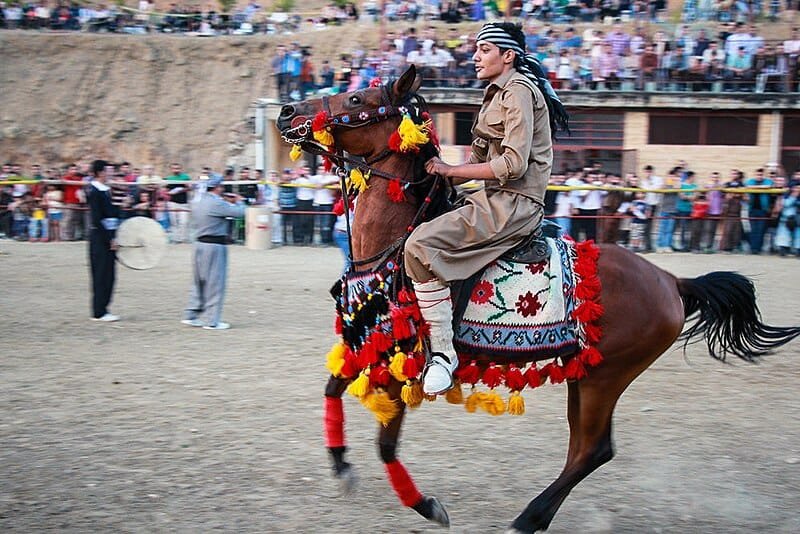The Majestic Kurdish Horse: A Symbol of Heritage and Strength
When it comes to symbols of cultural heritage and strength, few can rival the Kurdish horse. This remarkable breed, cherished by the Kurdish people, is not only a testament to the region’s rich history but also a living embodiment of its traditions and values. In this blog, we’ll explore the unique characteristics of the Kurdish horse, its historical significance, and why it remains an important part of Kurdish life today.
A Breed of Distinction
The Kurdish horse, known locally as “Kurdish Kurdi” or simply “Kurdish,” is a breed renowned for its resilience and versatility. These horses are medium-sized, typically standing between 14.2 and 15.2 hands high, and are characterized by their strong, athletic build. Their coat colors vary, but they often have a striking appearance with a shiny, smooth coat that ranges from deep bay to chestnut.
One of the standout features of the Kurdish horse is its endurance. These horses are well-suited to the rugged terrain of the Kurdish regions, including the mountainous areas of northern Iraq, southeastern Turkey, and parts of Iran and Syria. Their stamina and sure-footedness make them ideal for long journeys and challenging landscapes.
Feature details
| Feature | Details |
|---|---|
| Breed Name | Kurdish Horse (Kurdish Kurdi) |
| Height | 14.2 to 15.2 hands high (approximately 58 to 62 inches) |
| Build | Medium-sized, strong, athletic |
| Coat Colors | Varies from deep bay to chestnut, often with a shiny, smooth coat |
| Endurance | High; well-suited for rugged terrain and long journeys |
| Historical Use | Transportation, agricultural work, military campaigns, traditional games and competitions |
| Cultural Significance | Integral to Kurdish culture, featured in folklore, songs, and traditional events |
| Modern Role | Symbol of heritage, featured in festivals, races, and cultural celebrations |
| Conservation Status | Efforts are ongoing to preserve the breed and maintain its traditional characteristics |
| Challenges | Decline in traditional practices, political and economic instability in the region |
| Conservation Efforts | Breeding programs, educational initiatives, and promoting awareness about the breed’s significance |
Historical Significance
The Kurdish horse has a storied place in the history of the Kurdish people. For centuries, these horses have been integral to Kurdish culture and daily life. Historically, they have been used for various purposes, from transportation and agricultural work to military campaigns.
In ancient times, the Kurdish horse played a crucial role in warfare. The horses were prized for their speed and agility, making them valuable assets for Kurdish cavalry units. They were also used in traditional Kurdish games and competitions, showcasing their agility and strength.
The relationship between the Kurdish people and their horses goes beyond practical uses. The bond between horse and rider is a deep one, steeped in tradition and mutual respect. This connection is reflected in Kurdish folklore, songs, and even the art of horse grooming and training.
The Role in Modern Kurdish Culture
Today, the Kurdish horse continues to hold a special place in Kurdish culture. While modern technology and transportation have reduced the reliance on horses for practical purposes, the Kurdish horse remains a symbol of heritage and pride.
In Kurdish festivals and celebrations, horses often take center stage. Traditional horse races and riding events are popular and draw crowds from all over the region. These events are not just about competition; they are a celebration of Kurdish identity and a way to honor the historical significance of the breed.
Furthermore, the Kurdish horse is also a subject of conservation efforts. Organizations and enthusiasts within the Kurdish region are working to preserve the breed and maintain its traditional characteristics. This includes breeding programs and educational initiatives aimed at ensuring that future generations can continue to appreciate and benefit from the Kurdish horse.
Challenges and Conservation
Despite its rich heritage, the Kurdish horse faces challenges today. Modernization and changing lifestyles have led to a decline in traditional horse-related practices. Additionally, political and economic instability in the region has impacted efforts to support and preserve the breed.
Conservation efforts are crucial to ensuring the Kurdish horse does not become a relic of the past. These efforts involve not only preserving the breed but also promoting awareness about its historical and cultural significance. By educating people and encouraging the younger generation to take an interest in horse care and breeding, there is hope that the Kurdish horse can continue to thrive.


